Dr.Irfana Siddiqui
Assistant Professor
Department of Textiles and Apparel Designing
College of Community Science
VNMKV Parbhani
Email –siddiquiiefana 7@ gmail .com
Abstract
A survey was conducted among 30 numbers of sewing machine operators of Parbhani district who were involved in stitching of garments from 2 to 10 years. Selected group of 30 numbers of sewing machine operators were divided into two groups. First group of 15 were female and second group of 15 male following under age group between 35 to 55 years. A questionnaire was prepared & information was collected by interview method regarding workingplace of stitching, types of sewing machine used for stitching of garments, type of furniture used for seating, and health related problems faced by sewing machine operators during stitching of garments. Collected data was tabulated and presented in percentages. Considering the health problems of sewing machine operator and solving their health problems such as for reducing eye strain & headache neck pain, back pain, shoulder pain waist pain provided accessories such as , solar table lamp with peg arrangement, stand of sound micro phone system used and a bulb with holder ,wire and plug pin was tied in place of mic for supply sufficient light on machine head , hanging blub on wall near machine, wooden chair of hand and alarm watch were provided to sewing machine operators for use near about 30 days (month). After incorporation all provided accessories material feedback was collected from sewing machine operators( both male and female) about the each item whether items are beneficial , suitable ,provided advantage and economical minimize health problems. Acceptability & suitability of hanging bulb, solar table lamp with peg arrangement, iron stand of mic system with bulb ,alarm watch and cushion was assessed using Weighted Mean Score (WMS) rating scale for suitability level as Highly suitable/ acceptable- 3, Suitable/ acceptable-2.33 and Somewhat Suitable/ -1.66
Results showed that Cent percent of respondents male sewing machine operators stitched garment in tailor shop & female were stitched garment at home.Higher percentage male uses High speed sewing machine followed by sewing machine operated on mini motor and very few male using simple sewing machine foot operated. Maximum percentage female sewing machine operators used simple sewing machine foot operated followed by mini motor attached to foot operated sewing machine. It was also observed that none of female sewing machine operator use High speed sewing machine. Hanging bulb on wall side for bright light was preferred by the all ladies tailor found to be highly suitable acceptable followed by solar table lamp suitable regarding bulb tied on iron stand was found to be good arrangement of light but the stand is not available easily and costly, wooden chair with cushion and alarm watch was found to be highly suitable and acceptable and reduces the health problems 90 percent
A Study on Health Problems Faced by Sewing Machine Operators of Parbhani District While
Stitching of Garments
Methodology
A survey was conducted among 30 numbers of sewing machine operators of Parbhani district who were involved in stitching of garments from 2 to 10 years. Selected group of
30 numbers of sewing machine operators weredivided into two groups. First group of 15 were female and second group of 15 male following under age group between 35 to 55 years. A questionnaire was prepared & information was collected by interview method regarding health problems faced by sewing machine operators while stitching of garments, work station whether they stitched garment at home or went to the tailor shop, types of sewing machine, type of furniture used for sitting and health related problems faced by sewing machine operators during stitching of garments. Collected data was tabulated and presented in percentages.
Selection of supporting accessories for reducing health problems
- Solar table lamp with peg arrangement
- Sound micro phone stand (in place micro phone bulb is arranged for lighting)
- Hanging bulb on wall side at level of machine head
- Wooden chair of hand with cushion
- Alarm watch
| Health problems | Supporting Accessories provided to minimize health problems |
| Reducing eye strain & headache:
Provided a solar table lamp with peg arrangement. It is more flexible and provided full bright light on pressure foot and needle and for easy threading needle and to check proper stitches while stitching |
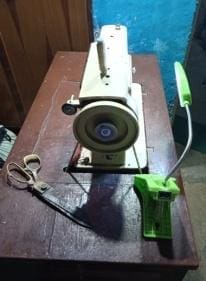 Solar Table Lamp |
| Provided hanging bulb with holder and pluck pin on the wall for get full bright light for putting thread in the needle quickly for reducing the eye strain and headache.as work of stitching is finished the bulb remove and keep aside. |
 Provided Bulb On Wall Nearby Sewing Machine |
| Provided iron stand of sound micro phone system having heavy round base because base use less floor space. In place of mic bulb is adjusted and hang ,stand rod can be adjusted at sewing machine head level exactly in front of machine ,full and bright light for reducing the eye strain, pain of eye & headache |
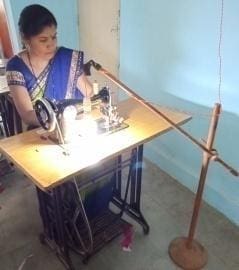 Stand Of Micro Phone System |
| Provided Wooden Chair of hand with cushion to take the back and hand rest feel comfortable while stitching garment | 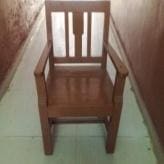 |
| Provided alarm watch and set for 1 hour , on each one hour as watch ring the alarm operators of sewing compulsory take break & move on machine drink water and do simple stretch hands and legs ,back , waist , neck and shoulder for minimize the body pain | 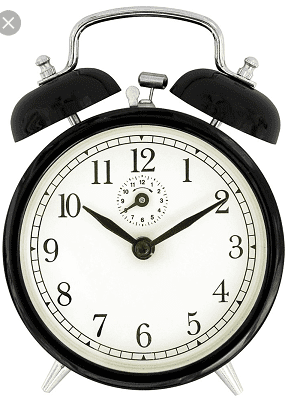 |
Evaluation of use of accessories
After one month provided accessory materials was evaluated & feedback was collected from the sewing machine operators on different parameter about each item is suitable , advantageous, beneficial, easy to get in the market economical acceptable and suitable for reducing health problems . Acceptability & suitability of provided accessory materials was assessed using Weighted Mean Score (WMS) rating scale for suitability level as Highly suitable/ acceptable- 3, Suitable/ acceptable-2.33 and Somewhat Suitable/-1.66.
Findings
Table.1 showed that general information about working place of sewing machine operators
Cent percent of male sewing machine operator reported that they stitched gent’s garments in Tailoring shop such as pajama, Nehru shirt , open shirt, trouser, pants and jacket from morning 10 o’clockto evening 8. pm with one hour break for lunch because the tailor master is cut garment and supply for stitching and all facilities provided of ironing, interlock machine and button and button hole making machine.Cent percent Female sewing machine operators were stitched ladies garments at home such as blouse, Punjabi Salwar and Punjabi top, baby frock, cap, hood, diaper and school uniform of girls, after all the house hold work finished
Table.1 General Information about working place of respondents for stitching garments
| S.no | Working place for stitching of garments | |||
| Male (N=15) | Female (N=15) | |||
| 1 | Tailoring shop | At home | Tailoring shop | At home |
| 2 | 15 (100) | No work at home | No work at tailoring shop | 15(100) |
Table.2 indicates that different types of sewing machine used by the respondents for stitching of garments . Higher percentage (73.33) male respondents reported that they use High speed sewing machine operating on electrical power because stitching was fast, production garments was more as compared to foot operated sewing machine followed by 13.33% respondents uses Foot operated sewing machine attached mini motor & simple sewing machine operators on foot.It is clear from the table Female respondents using mini motor attached to foot operated sewing machine that is 53.33 percent followed by simple sewing machine foot operated i:e 46.66 percent. It was also observed that none of female sewing machine operator using High speed sewing machine because it cost is high cannot be affordable and speed of machine cannot be controllable.
Table 2.Types of sewing machine used for stitching by sewing machine operators
| S.no | Types of sewing machine used | Sewing machine operators | ||
| Male (N=15) | Female (N=15) | |||
| 1 |  |
Foot operated sewing machine( Domestic machine) | 2(13.33) | 7(46.66) |
| 2 |  |
Foot operated sewing machine attached mini motor & operated on power | 2(13.33) | 8(53.33) |
| 3 |  |
High- speed sewing machine | 11(73.33) | — |
Table.3 illustrates that number of hours spent for stitching of garments and type of furniture used for sitting while stitching. Cent percent of male sewing machine operators were expressed that they spent 7 to8 hours daily and in season of Ramzan, Dessera, Diwali & in wedding season 12 to 15 hours daily spent for stitching as per the demand of customers. Female sewing machine operators were expressed that they spent 5 to 6 hours daily and in season 8 to 10 hours spent for stitching to full fill the demand of customers. Hundred percent male and female sewing machine operator reported that they used plastic and wooden tool for sitting while stitching because wooden stool is heavy in weight and not move during stitching.
Table.3.Number of hours spent for stitching of garments and type of furniture used for sitting
| S.no | Daily | Number of hours spent for stitching | ||
| Sewing machine operators | Reasons | |||
| Male(N=15) | Female (N=15) | |||
| 1 | Daily | 7 to 8 hrs | 5 to 6 hrs | As per the demand of customers |
| 2 | Daily,
( In season of Ramzan Diwali, Dessehra & wedding) |
12 to 15 hrs | 8 to 10 hr | As per the demand of customers |
| 3 | Wooden stool | 5(100) | 8(100) | Heavy in weight & not move during stitching |
| 4 | Plastic stool | 10( 66.66 ) | 7( 46.66 ) | Light in weight |
Table.4. indicates that health related problems faced by the sewing machine operators while stitching of garments. Cent percent of male and female sewing machine operators explained that they suffer from eye strain, headache the reason may be that they trying to do sewing work in poor light , dim lighting due it increased strain & stress on sight and pain in eye and headache. Upper back pain, lower back pain, neck pain ,shoulder pain, arms pain stomachache and swelling of legs happened due to using sitting stool too high or too low as the level machine table and another reason is that Poor posture and constant sitting in one position on a stool without backrest for minimizing above stated problems provided accessories and ask to used continuously for one month and feedback was collected.
Table.4. Health related problems faced by the sewing machine operators while stitching
| S.no | Problems | Respondents N=30 | Reasons of health problems face |
| 1 | Eye strain | 30(100) | Working in poor, dim lighting |
| Headache | 30(100) | ||
| 2 | Back pain | 30(100) | Using stool too high or too low as the level machine table |
| 3 | Lower back pain | 30(100) | Poor posture and constant sitting in one position on a stool without backrest |
| 5 | Neck pain | 25 (83.33) | |
| 6 | Shoulder pain | 25 (83.33) | |
| 7 | Stomachache | 12 (40) | |
| 8 | Arms pain | 10 (33.33) | |
| 9 | Swelling of legs | 10(33.33) |
Table-5 indicates Evaluation of accessories provided for minimizing health problems and suitability score.
1.Solar table lamp with peg arrangement
Provided solar table lamp with peg arrangement was found to be highly suitable and acceptable because charging is easy as work is finished it can remove and store safe . It is more flexible and provided full bright light directly on pressure foot and needle that helped for easy threading in needle and to check proper finishing and checking of stitches while stitching and Reduces eye strain & headache near about 90 percent with in 30 days.
- Hanging bulb on wall side at level of machine head
Respondents reported personal experience after using arrangement of hanging bulb on wall at the level of machine head for sufficient light was found to be Highly suitable acceptable and advantageous and beneficial ideas for provide light source in day and night timing stitching garment happy without strain ,pain in aye and headache.
- Sound micro phone stand in place micro phone bulb is arranged for lighting
Respondent reported experiences about stand is found to be suitable but it cost is more and unable to purchased hence this technique of light providing somewhat suitable
- Wooden chair of hand with cushion
Respondents reported their personal experiences regarding using wooden chair of straight back rest and hand rest with cushion was highly suitable and acceptable and found to be comfortable sitting and to take rest back and hand, height of chair can be adjusted by keeping two or more cushion for comfortable stitching due to such adjustment minimized body pain such as neck, shoulder ,back ,arms and waist
- Alarm watch
Respondents stated that Provided alarm watch was found to be highly suitable acceptable and advantageous idea that setting of time 1 hour for alarm and alarm forced to respondent and reminding to stop stitching ,get up , leave machine and compulsory take break drink water and do simple stretch hands and legs . Stretching of body parts helped and reduces back, waist, neck and shoulder pain
Table -5. Evaluation of accessories provided for minimizing health problems
| S.no | Accessories provided for minimize health problems | Suitability level (WMS) N=30 | Acceptable & suitable |
| 1 | Solar table lamp with peg arrangement | 3.00** | Highly suitable |
| 2 | Sound micro phone stand in place micro phone bulb is arranged for lighting | 1.67 | Suitable |
| 3 | Hanging bulb on wall side at level of machine head | 3.00** | Highly suitable |
| 4 | Wooden chair of hand with cushion | 3.00** | Highly suitable |
| 5 | Alarm watch | 3.00** | Highly suitable |
Conclusion
It can be concluded from the study that as per the practical experiences of respondents reported by using all items and accessories reduces health problems developed interest in stitching solar table lap ,hanging bulb and wooden chair and alarm watch was found to be highly suitable acceptable and comfortable for daily use and reducing health problems and due to this ideas speed of stitching was increased, checking of straight stitching ,turning and folding of fabric was found to be easy and production of garment increases and accessories are economical.
| Sufficient light arrangement | Practical experiences of sewing machine operators | Feedback of sewing machine operators |
 Provided hanging bulb on wall |
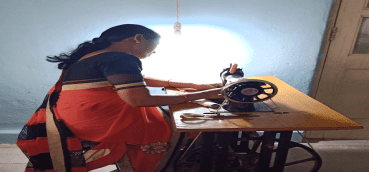 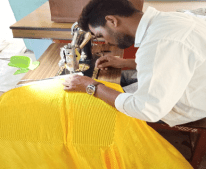 |
|
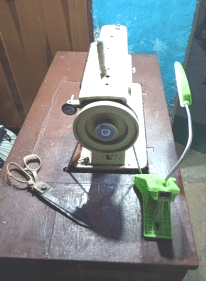 Provided solar lamp |
 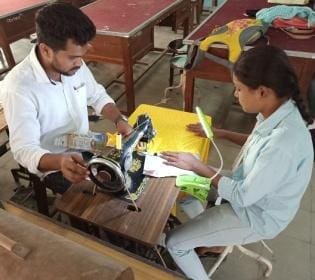 |
|
